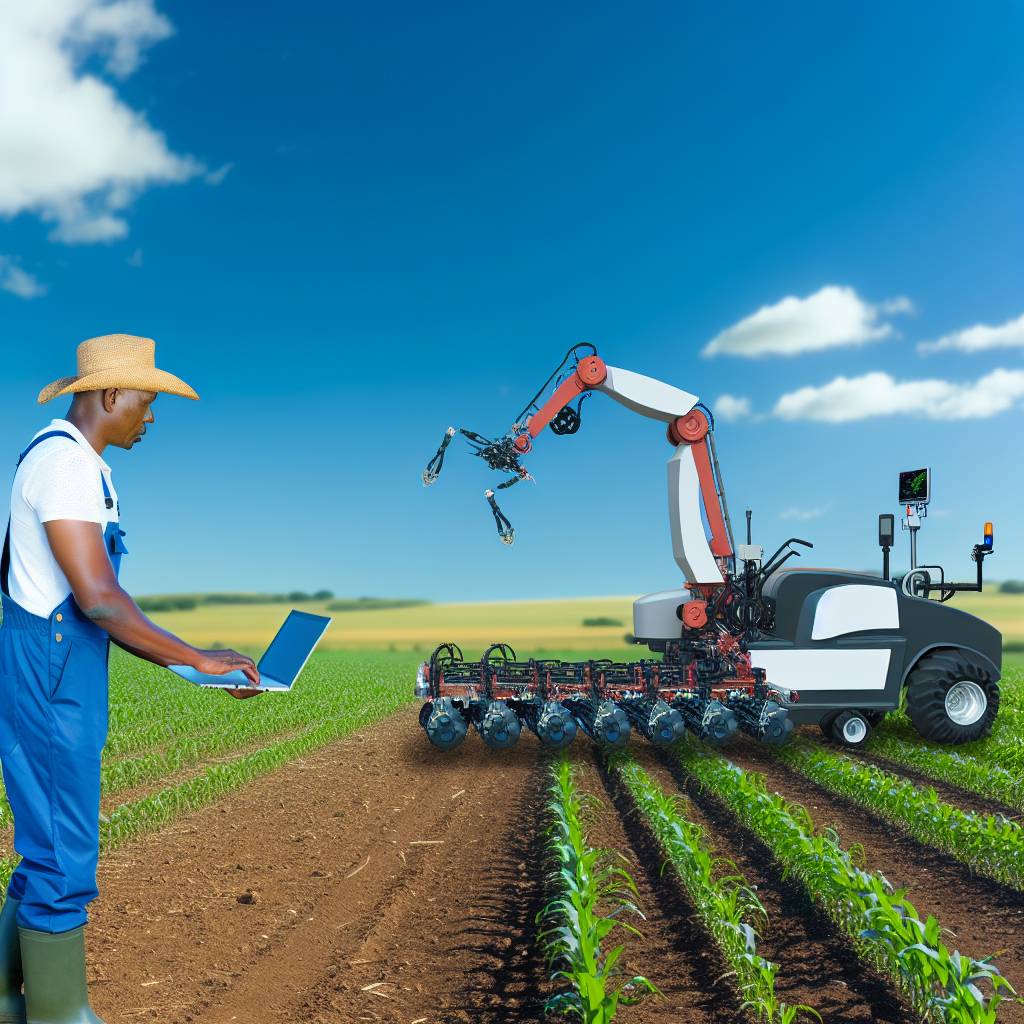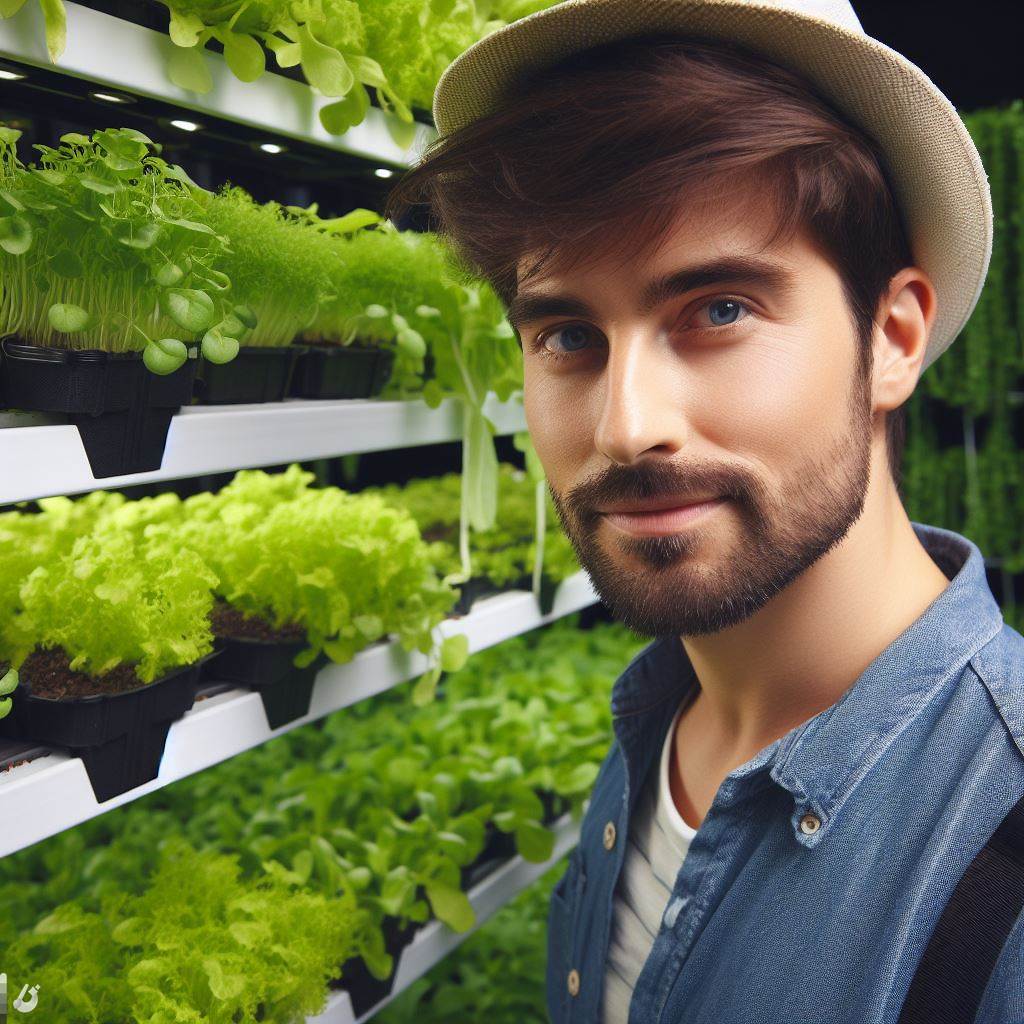Introduction to Automated Farming Machinery
Automated farming machinery represents a revolution in agriculture.
This technology enhances efficiency and productivity on farms.
Farmers harness automation to meet growing global food demands.
Moreover, it helps reduce the labor costs associated with traditional farming.
Benefits of Automation
One major benefit is increased operational efficiency.
Automated machinery can perform tasks faster than human laborers.
Additionally, these machines offer precision in planting and harvesting.
As a result, farmers achieve higher crop yields with less waste.
Types of Automated Machinery
Various types of automated machinery exist today.
Tractors equipped with GPS technology lead the way.
These tractors can operate autonomously on large fields.
Additionally, drones play a crucial role in monitoring crop health.
Impact on Labor
The introduction of automated farming machinery changes workforce dynamics.
While some jobs may diminish, new roles emerge in technology management.
Farmers can redirect human resources to other critical tasks.
Transform Your Agribusiness
Unlock your farm's potential with expert advice tailored to your needs. Get actionable steps that drive real results.
Get StartedTraining programs become essential to equip workers for the future.
Future Trends
The future of automated farming looks promising.
Advancements in artificial intelligence will enhance automation further.
Farmers will rely on data analytics to make informed decisions.
Ultimately, automated farming machinery will continue to shape the agricultural landscape.
Benefits of Automation in Agriculture
Enhanced Productivity
Automated farming machinery significantly boosts productivity on farms.
It reduces the time required for planting and harvesting crops.
Farmers can manage larger areas with less labor.
This leads to increased yields and better resource utilization.
Cost Savings
Automation helps farmers lower operational costs.
Fewer workers are needed for manual tasks.
Additionally, machinery can operate efficiently without breaks.
These factors result in reduced labor expenses over time.
Precision Farming
Automated systems enable precise planting and application of inputs.
This reduces waste and maximizes crop health.
The technology can monitor soil health and moisture levels.
Farmers receive real-time data to make informed decisions.
Environmental Impact
Automation minimizes environmental harm in agriculture.
It allows for more efficient use of fertilizers and pesticides.
Less runoff leads to improved water quality in nearby areas.
Moreover, automated machinery can reduce fuel consumption.
Labor Challenges
Many farmers face a shortage of skilled labor.
Automation provides a viable solution to this issue.
It allows for continuous operation without interruption.
Showcase Your Farming Business
Publish your professional farming services profile on our blog for a one-time fee of $200 and reach a dedicated audience of farmers and agribusiness owners.
Publish Your ProfileAs a result, farmers can keep up with growing food demands.
Safety Improvements
Automated farming machinery can enhance safety for workers.
It handles dangerous tasks that could expose workers to risks.
Additionally, technology can monitor work environments for hazards.
This ensures farmers prioritize worker safety on their fields.
Types of Automated Farming Machinery
Tractors
Tractors serve as the backbone of many farms.
They enable farmers to perform various tasks efficiently.
Modern tractors often include GPS technology for precision farming.
This enhances field mapping and crop management.
Drones
Drones have transformed agricultural monitoring.
Farmers use drones to survey large areas quickly.
These devices gather data on plant health and soil conditions.
Additionally, they can assist in crop spraying with precision.
Autonomous Harvesters
Autonomous harvesters significantly reduce labor costs.
These machines can navigate fields and harvest crops without a driver.
They increase efficiency and minimize crop damage during harvest.
Moreover, they operate around the clock in optimal conditions.
Robotic Planters
Robotic planters bring a new level of accuracy to seeding.
They ensure even spacing and depth for each seed planted.
This technology maximizes germination rates and crop yields.
Furthermore, they can adapt to different soil conditions dynamically.
Smart Irrigation Systems
Smart irrigation systems optimize water usage.
They automatically adjust based on weather conditions and soil moisture.
This helps conserve water and ensures crops receive adequate hydration.
Consequently, farms experience increased productivity and sustainability.
Weed Control Robots
Weed control robots efficiently manage unwanted plants.
They identify and remove weeds with minimal impact on crops.
These robots reduce the need for chemical herbicides.
As a result, they promote environmentally friendly farming practices.
Uncover the Details: Sustainable Fertilizer Technologies Reducing Environmental Footprint
Case Studies: Successful Implementation of Automation
Introduction to Case Studies
Numerous farms have embraced automated machinery successfully.
These implementations showcase efficiency and innovation.
Let’s explore some notable examples of this trend.
Riverside Farms: Precision Agriculture
Riverside Farms adopted automated tractors for precision agriculture.
This technology enables precise planting and fertilization.
As a result, the farm reduced waste significantly.
Labor costs diminished as fewer workers were needed.
Moreover, increased yield improved their profit margins.
Greenway Orchards: Harvest Automation
Greenway Orchards implemented robotic harvesters last season.
The robots efficiently picked fruits, surpassing human capabilities.
Showcase Your Farming Business
Publish your professional farming services profile on our blog for a one-time fee of $200 and reach a dedicated audience of farmers and agribusiness owners.
Publish Your ProfileConsequently, the orchard increased its harvest window.
Additionally, the loss from overripe fruits decreased.
This change directly contributed to a higher quality product.
Sunny Acres Dairy: Milking Machines
Sunny Acres Dairy upgraded to automated milking machines.
This transition allowed cows to be milked at their convenience.
Hence, milk production rose while stress levels fell.
The farm achieved better financial stability as a result.
Furthermore, the quality of milk improved significantly.
Lakeside Vineyard: Vineyard Management
Lakeside Vineyard integrated drones for vineyard management.
Drones monitor crop health and soil conditions with ease.
This data-driven approach enhanced their decision-making process.
Consequently, they optimized water usage and increased productivity.
As a result, overall operational efficiency improved markedly.
Impacts of Automation in Agriculture
These case studies illustrate the benefits of automated farming machinery.
Efficiency, reduced labor costs, and increased yields are evident.
As technology advances, more farms will likely follow suit.
The future of agriculture appears bright with automation.
Explore Further: Enhancing Crop Yields With Biotechnology Techniques
Challenges and Limitations of Automated Farming Technologies
Technical Limitations
Automated farming technologies often face technical challenges.
For instance, malfunctioning equipment can disrupt entire operations.
Additionally, the integration of new technologies can be complex.
Farmers may struggle with the steep learning curve required.
Cost Considerations
The initial investment for automated machinery can be considerable.
Small-scale farmers may find it difficult to afford these costs.
Moreover, maintenance and repair expenses add to the overall budget.
These financial challenges can deter many from adopting automation.
Dependence on Technology
Reliance on automated systems can lead to vulnerabilities.
For example, power outages can halt operations entirely.
Additionally, farmers may become overly dependent on technology.
This dependence might reduce traditional farming skills over time.
Data Privacy and Security Risks
Automated farming relies heavily on data collection and analysis.
This can raise concerns about data privacy and security.
Cyberattacks on farming operations could lead to significant losses.
Farmers must address these risks to protect their information.
Environmental Impact
Automated farming can have unintended environmental consequences.
Over-reliance on fertilizers and pesticides may increase soil degradation.
Moreover, machinery can compact soil and disrupt ecosystems.
Balancing efficiency and sustainability is a key challenge.
Find Out More: Energy Efficient Automated Machinery For Sustainable Farms

Future Trends in Farming Automation: Innovations on the Horizon
Integration of AI and Machine Learning
Artificial intelligence is transforming farming practices.
Showcase Your Farming Business
Publish your professional farming services profile on our blog for a one-time fee of $200 and reach a dedicated audience of farmers and agribusiness owners.
Publish Your ProfileFarmers use data-driven insights to enhance crop yields.
Machine learning models analyze weather patterns effectively.
These advancements lead to precision agriculture.
Farmers benefit from tailored recommendations.
Development of Autonomous Equipment
Autonomous tractors are becoming increasingly common.
They perform tasks without requiring human intervention.
This trend optimizes labor usage and reduces costs.
Additionally, robotic harvesting systems are emerging.
These systems improve harvesting efficiency in fields.
Utilization of Drones in Farming
Drones play a crucial role in modern agriculture.
They provide aerial imagery for crop assessment.
This technology enables farmers to monitor crop health.
Moreover, drones assist in precision application of fertilizers.
Farmers can manage their resources more effectively.
Advancements in Smart Irrigation Systems
Smart irrigation systems enhance water conservation.
They utilize sensors to monitor soil moisture conditions.
This results in optimized water usage during irrigation.
Consequently, farmers save on irrigation costs.
Smart systems adapt to changing weather patterns efficiently.
Emergence of Vertical Farming Technology
Vertical farming presents innovative agricultural solutions.
This approach maximizes space in urban environments.
Hydroponics and aeroponics facilitate soil-less farming.
As a result, crops can grow year-round.
This technology boosts food security in urban areas.
Gain More Insights: Regulatory Guidelines For Growing Genetically Modified Crops
Integrating Automated Machinery with Traditional Farming Practices
The Role of Automation in Farming
Automation in farming streamlines various agricultural processes.
Farmers can enhance productivity by reducing manual labor requirements.
Additionally, automated machinery improves precision farming techniques.
Benefits of Combining Tradition with Technology
Integrating traditional methods with automated practices fosters better yields.
This combination also helps in sustaining local farming cultures.
Farmers can utilize technology for improved soil management.
Moreover, it enables the monitoring of crop health effectively.
Examples of Automated Farming Equipment
Modern tractors equipped with GPS can optimize field coverage.
Drones assist in mapping fields and monitoring crops from above.
Robotics can handle tasks like planting and harvesting efficiently.
Smart irrigation systems adjust watering schedules based on real-time data.
Strategies for Successful Integration
Farmers should start with small-scale automation projects.
Gradually implementing technology minimizes disruption of existing practices.
Training staff is crucial to ensure everyone is comfortable with new tools.
Networking with other farmers can provide valuable insights.
Showcase Your Farming Business
Publish your professional farming services profile on our blog for a one-time fee of $200 and reach a dedicated audience of farmers and agribusiness owners.
Publish Your ProfileChallenges to Consider
Initial costs of automated machinery can be high for some farmers.
Additionally, there may be a learning curve associated with new technologies.
Farmers might face resistance when changing traditional practices.
Furthermore, maintaining automated machines requires ongoing support.
Economic Impacts: Cost-Benefit Analysis of Automation in Farming
Overview of Automation Costs
Investing in automated farming machinery requires upfront capital expense.
Initial costs include purchasing and maintaining advanced equipment.
Farmers must assess depreciation and potential repair costs as well.
Training staff to operate these machines adds to the overall investment.
Potential Savings Through Automation
Automated machinery streamlines farming processes significantly.
Efficiency leads to reduced labor costs in the long run.
Furthermore, automation minimizes the risk of human error.
This accuracy enhances overall crop yield and quality.
Increased Productivity and Profitability
Automation allows for faster planting, tending, and harvesting cycles.
As a result, farmers can manage larger areas of land efficiently.
Higher productivity translates into increased market opportunities.
Consequently, many farmers report improved profit margins.
Long-Term Financial Viability
Investing in automation enhances the sustainability of farming operations.
Over time, these investments can pay for themselves through savings.
Moreover, farmers gain a competitive edge in a rapidly evolving market.
This strategic position can foster growth and expansion potential.
Environmental Considerations
Automated machinery often results in more precise resource management.
Efficient use of water and fertilizers leads to lower environmental impact.
Consequently, sustainable practices improve public perception and support.
This elevates marketability among environmentally conscious consumers.
Real-World Examples of Automation Success
Several farms have experienced significant improvements post-automation.
Green Valley Farms reported a 30% increase in yield after upgrading.
Sunny Acres utilized drones for monitoring and achieved 20% lower costs.
These cases highlight the transformative potential of automation in agriculture.
Additional Resources
AI in Agriculture and Farming: Revolutionizing Crop Growth – Intellias




